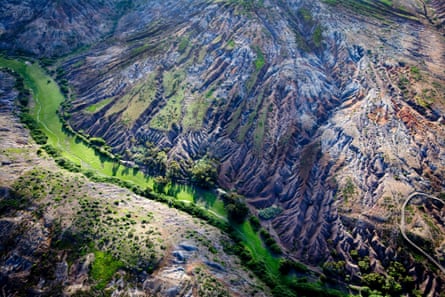The “world’s most useless airport” is about to welcome its first commercial passenger flight – five years later than planned. Environmental and geographical challenges famously delayed the opening of the airport on St Helena, one of the most isolated inhabited islands on the planet, and the project, which cost the British government £285m, was saddled with the unfortunate moniker.
But on 14 October an SA Airlink aircraft will touch down on the infamous runway after a six-hour flight from Johannesburg (refuelling in Windhoek, Namibia, en route). With it will arrive 68 passengers and a new chapter in the history this tiny volcanic outpost in the middle of the south Atlantic.

Until now St Helena – a British overseas territory 1,200 miles off the coast of south-west Africa, measuring 10 miles by five – has only been accessible by Royal Mail ship (RMS St Helena). That six-day journey from Cape Town can cost up to £4,138. So a lot is riding on the new, weekly flight.
In 2010, the British (then coalition) government justified the cost of the airport arguing that the “additional short-term costs of constructing an airport are outweighed by the long-term benefits.” The island receives more than £53m in aid every year and the average annual salary of the 4,534 inhabitants is only £7,280. While islanders and history buffs may mourn the loss of RMS St Helena, which makes her final voyage on 5 February 2018, it is hoped the increase in tourism will provide a much needed boost for the island’s struggling economy as aid is reduced. More flights will have to be added if the airport is to be deemed a success – and not an expensive white elephant.

Between May 2016 and May 2017, St Helena had just 3,795 visitors. A government report published in 2011 predicted that the new airport would increase tourism to 30,000 a year, eventually helping Saints, as the islanders are known, to become financially self-sufficient.
But progress is as slow as life on the island: it only got mobile phone reception in 2015. The first luxury hotel on the island, the 30-bedroom Mantis St Helena in the capital, Jamestown, is opening to coincide with the start of the new flight on 14 October. Otherwise, St Helena has a handful of guesthouses and B&Bs, many of which aren’t online and can only be contacted through the tourist office.
Nevertheless, in a world where remoteness is seen as a luxury, the chance to promote holidays to this speck of land has interested travel companies. Discover the World is one of the first UK tour operators to sell trips using the scheduled flights. Its seven-day fly-drive trip highlights the island’s diverse landscapes (from arid coastline to lush interior), wildlife (more than 500 species are not found anywhere else) and history. At £2,450pp for the week, it doesn’t come cheap, and even independent travellers will have to pay £804 for a return flight from Johannesburg.

For locals, improved access is an opportunity to rebrand the island as somewhere other than just “the place where Napoleon died” and to reveal its other assets. As well as the diverse geology – showcased in 21 “post box walks” – the surrounding waters are a magnet for marine life. Whale sharks gather off shore in large numbers from November to May and humpback whales migrate through its waters from June to December. Both can be seen on diving and boat trips by local company Into the Blue.
Other, more controversial developments, include a golf resort and the development of Rupert’s Bay harbour to allow cruise ships to dock on the island. Exactly what impact these changes will have on St Helena remains unclear but, as one of the islanders might say, it will never again be the same as “the before days”.

Comments (…)
Sign in or create your Guardian account to join the discussion